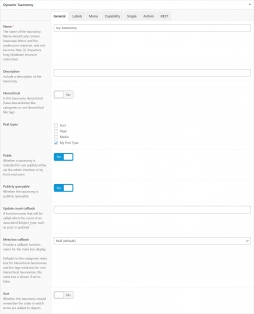#Taxonomies UIFREE
The Dynamic Taxonomies module allows you to register and manage custom taxonomies from your WordPress admin, in Tools > Taxonomies menu.
All native taxonomies settings can be set within the UI. ACF Extended also adds more advanced settings allowing to manage posts per page, order etc…
The name of the taxonomy. Name should only contain lowercase letters and the underscore character, and not be more than 32 characters long (database structure restriction)
Include a description of the taxonomy
Is this taxonomy hierarchical (have descendants) like categories or not hierarchical like tags. Default: false
The name of the object type for the taxonomy object. Object-types can be built-in Post Type or any Custom Post Type that may be registered. Default is None.
Whether a taxonomy is intended for use publicly either via the admin interface or by front-end users. The default settings of publicly_queryable, show_ui, and show_in_nav_menus are inherited from public. Default: true.
Whether the taxonomy is publicly queryable. Default: value of public
A function name that will be called when the count of an associated object_type, such as post, is updated. Works much like a hook. Default: None.
Whether terms in this taxonomy should be sorted in the order they are provided to wp_set_object_terms(). Default null which equates to false.
Whether to generate and allow a UI for managing terms in this taxonomy in the admin. Default: value of public.
Whether to list the taxonomy in the Tag Cloud Widget controls. Default: value of show_ui.
Whether to show the taxonomy in the quick/bulk edit panel. Default: value of show_ui.
Whether to display a column for the taxonomy on its post type listing screens. Default: false.
Which template file to load for the archive query. Default: Template hierarchy
Number of posts to display in the archive page. Default: 10
Sort retrieved posts by parameter in the archive page. Defaults: date (post_date).
Designates the ascending or descending order of the orderby parameter in the archive page. Defaults: DESC.
Set to false to prevent automatic URL rewriting a.k.a. "pretty permalinks". Pass an argument array to override default URL settings for permalinks
Use additional rewrite arguments
Used as pretty permalink text (i.e. /tag/). Default: value of name
Allowing permalinks to be prepended with front base. Default: true.
Either hierarchical rewrite tag or not. Default: false.
Number of terms to display on the admin list screen
Sort retrieved terms by parameter in the admin list screen. Accepts term fields name, slug, term_group, term_id, id, description, parent, count (for term taxonomy count), or none to omit the ORDER BY clause
Designates the ascending or descending order of the orderby parameter in the admin list screen. Default: ASC.
An array of labels for this taxonomy. By default tag labels are used for non-hierarchical types and category labels for hierarchical ones.
Default: if empty, name is set to label value, and singular_name is set to name value.
An array of the capabilities for this taxonomy:
manage_terms : edit_posts
edit_terms : edit_posts
delete_terms : edit_posts
assign_terms : edit_posts
Whether to include the taxonomy in the REST API. You will need to set this to true in order to use the taxonomy in your gutenberg metablock. Default: false.
To change the base url of REST API route. Default: name.
REST API Controller class name. Default: WP_REST_Terms_Controller
#Active TaxonomiesPRO
The pro version allows developers to manually activate Taxonomies individually using the “Active” switch in the sidebar.
#Json/PHP SyncPRO
The module is shipped with a fully functional Json/PHP Sync feature, cousin of the native ACF Field Group Json/PHP Sync.
#Advanced Usage
Set settings in PHP on existing taxonomies or Export/Import using Json files.
#Hide Module Menu
ACF Extended use the native ACF setting show_admin to determine if the module menu should be displayed or not. You can read more about that setting on the ACF article How to hide ACF menu from clients. Usage example:
add_filter('acf/settings/show_admin', '__return_false');#Disable The Module
The Taxonomies module is enabled by default. It can be enabled and disabled in the Settings UIPRO, or with the following code:
#Using acf/init
add_action('acf/init', 'my_acfe_modules');
function my_acfe_modules(){
// disable taxonomies
acf_update_setting('acfe/modules/taxonomies', false);
}#Using acfe/init
add_action('acfe/init', 'my_acfe_modules');
function my_acfe_modules(){
// disable taxonomies
acfe_update_setting('modules/taxonomies', false);
}
